10g (9.0.4) for Windows
Part Number B10272-01
Home |
Contents |
Index |
| Oracle Discoverer Desktop User's Guide 10g (9.0.4) for Windows Part Number B10272-01 |
|
This chapter describes the basic procedures for working with Discoverer Desktop to analyze data.
The topics covered in this chapter include:
The Discoverer Tools menu gives you a range of tools for analyzing your Discoverer data. For example, tools for creating and managing Conditions, data Sorts, Calculations etc, (see Figure 5-1 below).
Workbook behaviors that you define using the tools are known as Tool Definitions. Examples of Tool Definitions are

Select an option from the Tools menu to see the definitions you have already created for the tool. You turn a tool definition on and off by adding or removing the checkmark in front of its name in the tool's dialog box.
Turning on a tool definition applies it to the data in the table or crosstab. The results are then displayed according to the specifications of the tool. For example, turning on (applying) a condition filters the data to show the precise information you want to see. Similarly, turning on a set of totals definitions with the Totals tool calculates and displays subtotals and Grand Totals in your data.
Turning off a tool definition returns the data to its original form. For example, turning off a condition re-displays the data previously filtered out by the condition, and turning off totals displays the data again without subtotals and Grand Totals.
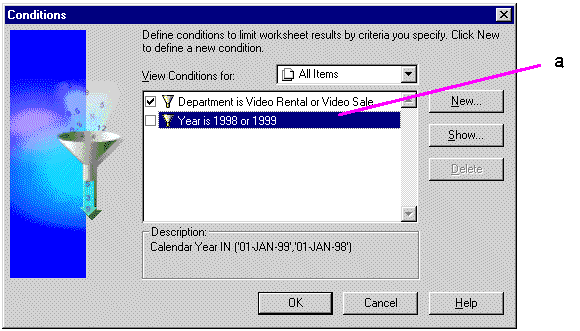
When creating a tool definition, you select whether to assign it to all data items or to a single item. Use the View drop-down menu to see the definitions assigned to various items, (see Figure 5-3 below).
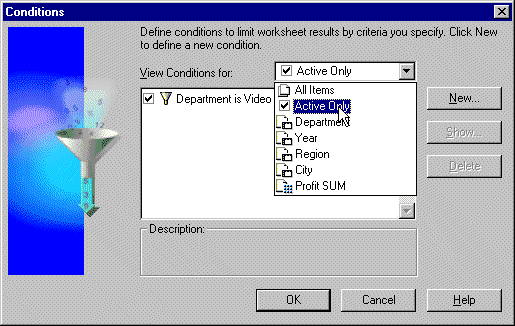
To see definitions for different items:
The list of definitions in the dialog box pertain to the selected item in the drop-down list. To see all of the definitions for the worksheet, choose All Items. To see only those currently turned on, choose Active Only.

Each tool has its own features, but the initial process to create a new definition is similar.
To create a new definition:
The tool's dialog box appears.
A dialog box appears for creating a new definition for that tool.
Each New dialog box is different. See the descriptions in the rest of this chapter for details on how to create a new definition for each tool.
To edit a tool definition, you must select it first on the list of definitions:
The tool's dialog box appears.

A dialog box appears for editing the definition.
Each dialog box for editing a definition is different. See the descriptions in the rest of this chapter to see how to edit definitions for each tool.
Although you can delete definitions, you may want to simply turn them off instead. Then, if you need a definition later, you can just turn it back on.
Deleted definitions are erased permanently. If you delete a definition and want to reuse it later, you will have to re-create that definition from the beginning.
To delete an existing tool definition:
The tool's dialog box appears.
The definition is deleted and removed from the list of definitions.
A typical analysis task is to find numerical data that meets or exceeds a particular amount (that is, data that is an Exception to the rest of the data). For example, you may want to find all the stores in your nationwide chain that have profits in excess of $10,000 for the year.
Finding Exceptions to the data involves two steps:
Use the Exception dialog box for both steps. Figure 5-6 shows an example.
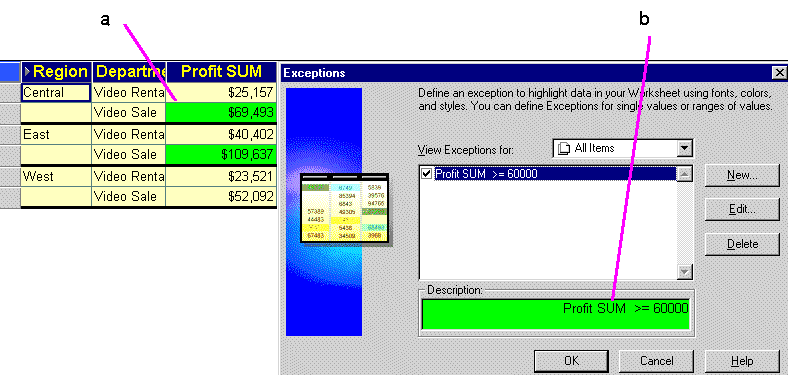
To turn on an Exception:
The Exceptions dialog box appears. It shows the Exceptions you have already defined.
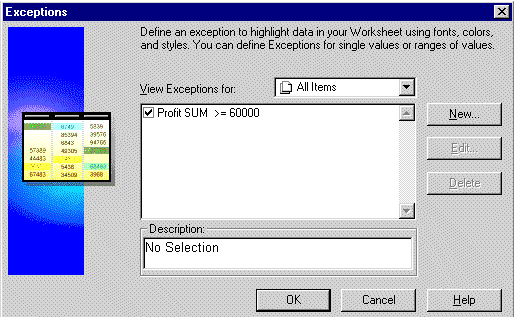
In the example above, the Exception "Profit SUM >= 60000" is turned on.
Discover now analyzes the data, finds the Exception data, and displays it according to the format of the Exception's definition.
To turn off an Exception:
The Exceptions dialog box appears.
To create a new Exception:
The Exceptions dialog box appears.
The Exception dialog box for a new Exception appears:
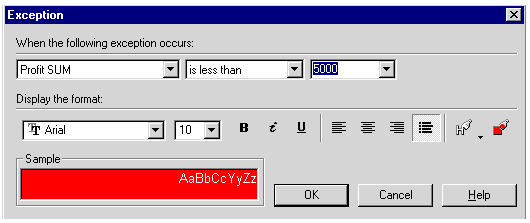
Creating a new Exception has two parts: defining the Exception and defining its format. The top portion of the dialog box is for defining the Exception; the bottom part is for the formatting.
To create the Exception definition:

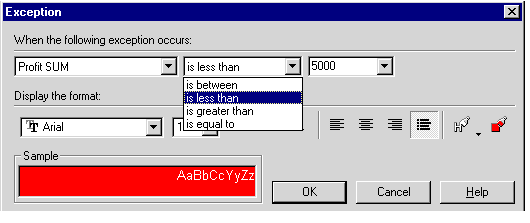
The following table shows some examples of the types of expressions you can define for Exceptions.
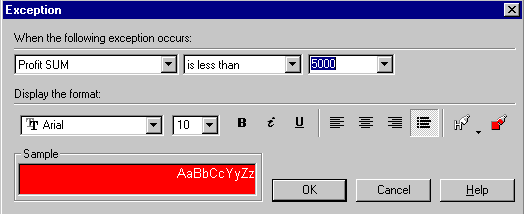
If you select a data item with discrete values, such as Region, and then select the expression "is equal to" you don't have to type in the value. Simply click the drop-down button on the third box to see the list of values for that item.
For example, in the sample Vidstore workbook, the three values for Region are Central, East, and West. Selecting "Region is equal to" and then clicking the drop-down button displays Central, East, and West as the choices.
To format the Exception:
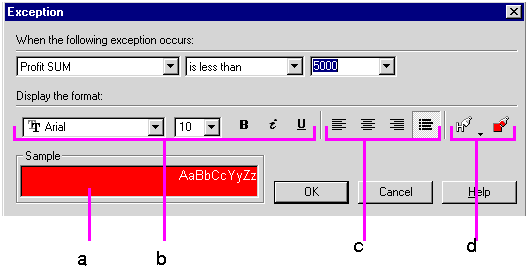
The Exceptions dialog box reappears with your new Exception listed in it. Remember to click the box in front of the Exception to turn it on and click OK to apply it to the data.
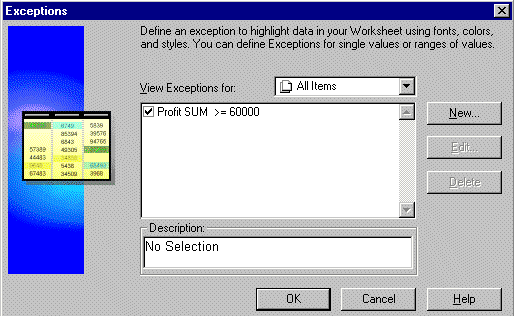
To edit an Exception:
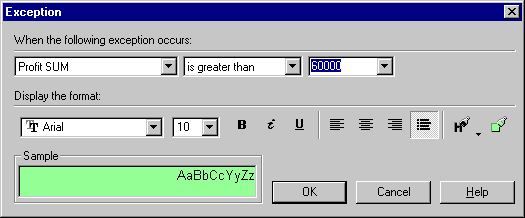
In this example, the Exception "Profit SUM greater than 60000" is selected. The Description at the bottom of the box shows the current Exception and its format.
If you now want to apply the edited Exception to your data items, make sure it is turned on (the check box in front of the Exception is selected) and click OK.
When working with numeric items, you often want to see various types of summations of the data. Using the Totals tool you can sum rows and columns of numbers, find averages and standard deviation, compute subtotals and Grand Totals, and so on. The Totals tool automatically places the summations at the appropriate positions on the display.
Here are some examples:
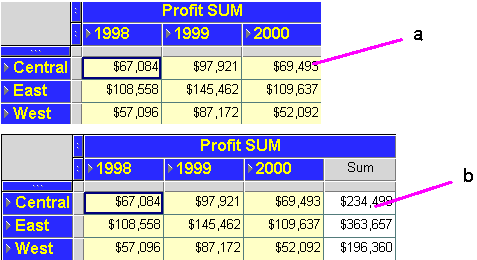
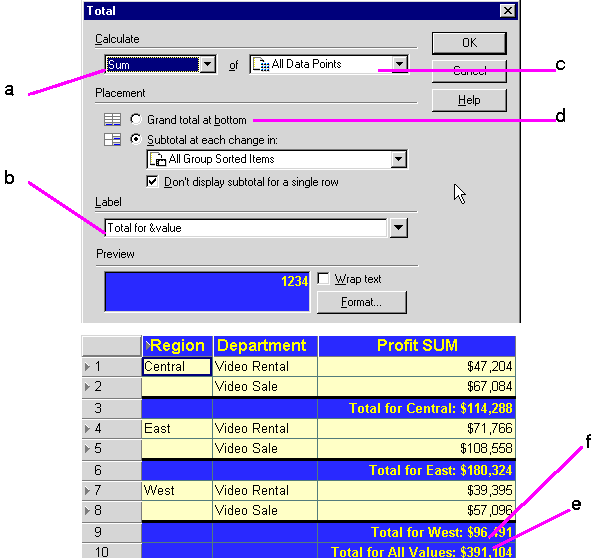
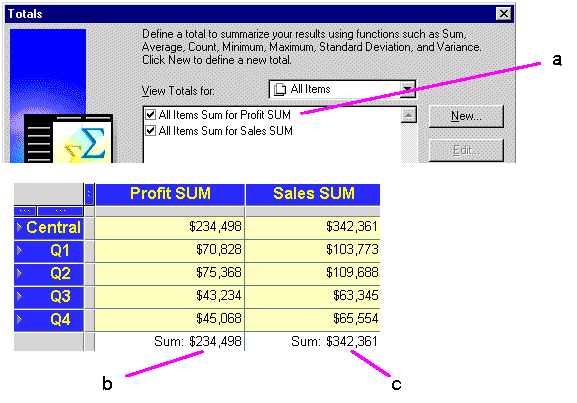
Notice that the two Totals are displayed on the same row. When a crosstab has multiple Totals active, Discoverer puts them on the same row.
To display totals or subtotals on a table or crosstab:
The Totals dialog box appears. It shows any totals you've already defined.
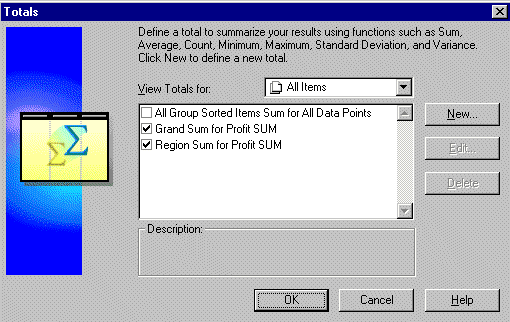
To remove the totals from the data:
The Totals dialog box appears.
Creating a new totals definition has four basic steps:
To create a new totals definition:
The Totals dialog box appears (Figure 5-18).
The Total dialog box for a new totals appears.
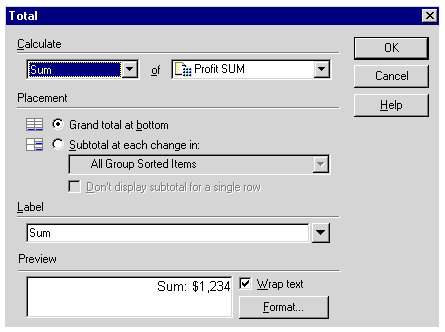
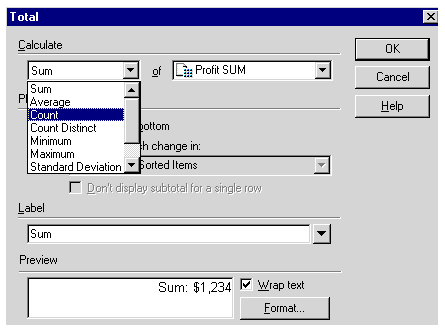
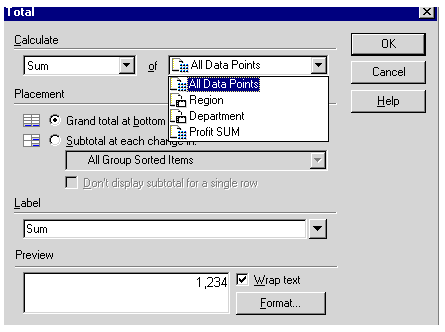
All Data Points-- displays totals for each set of appropriate data points. For example, if the table contains two columns of numeric data points, both columns display totals. However, data points not appropriate for the type of total are not displayed.
In the example above, Region is a set of data points, but summing Region data points doesn't make sense--it would be like trying to add "Central" to "East". In this case, Regions are not summed even though you selected All Data Points.
A specific numeric data point (such as Profit SUM in the example)--displays totals for the selected set of data points.
A non-numeric data point (such as Region in the example)--when you select a non-numeric set of data points, the options for the totals in the first drop-down list are limited to only those options that apply to non-numeric data points. For example, if you select Region, sum of regions does not make sense. The only totals that make sense for non-numeric data points are Count, Count Distinct, Maximum, and Minimum.
|
NOTE: If you choose the All Data Points option when your Worksheet contains Calculations, the Calculation is applied to the Totals. Discoverer does not total the Calculations, (see Section 5.3.2, "Totals and Calculations"). |
Grand total at bottom--Calculates the Grand Total for a column and places it after the last row of the table or crosstab.
Grand total at right--Calculates the Grand Total for a row and places it to the right of the last column in the crosstab. (This option is only available from the Total dialog box for crosstabs.)
Subtotal at each change in--Calculates the subtotals for a column and places it at each new value for the selected item. Select the item from the drop-down list. For example, the subtotals for Regions appear at the end of the data for each Region.
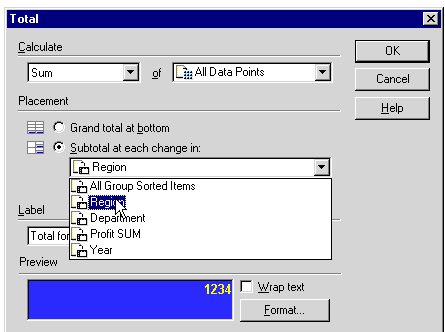
You can click the drop-down menu for labels and choose additional options for the title from it.
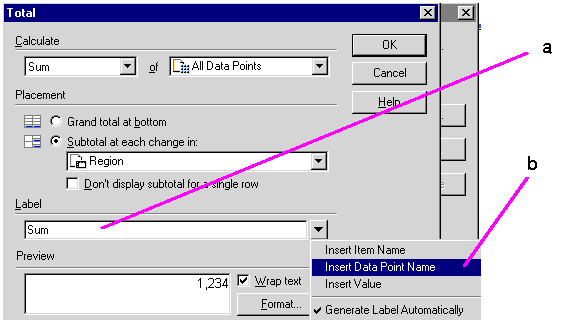
The system values from the drop-down list produce labels that can change as the data changes by adding text codes (such as "&Item" and "&Value") to the label when you insert them in the label text. In the actual labels on the table or crosstab, the ampersand (&) will not appear, and appropriate names from the table or crosstab will be inserted in place of the words "Item" or "Value".
This table shows some examples.
If the total calculates for all data points (as selected at the top of the dialog box), the labels can appear for each appropriate name. For example, when totaling two items, and you select Insert Item Name (&Name), labels for both item names appear in the data or crosstab.
To remove options from the labels, click in the label text on the dialog box and edit it as you would regular text.
You'll now see the Totals dialog box again with your new total definition listed in it.
When creating your Totals, if you total a Calculation, the Calculation is applied to the Total. Discoverer does not total the Calculations.
For example, in Figure 5-24, the Profit Item is a Calculation: Sales SUM / Cost SUM. The Sum value for Profits is $3.23, ($1,150,603 / 356,087). The SUM value is NOT $9.70, ($3.20 + $3.23 + $3.27).

|
NOTE: If you want Discoverer to total Calculations rather than apply the Calculations to Totals, contact your Discoverer manager. |
To edit a totals definition:
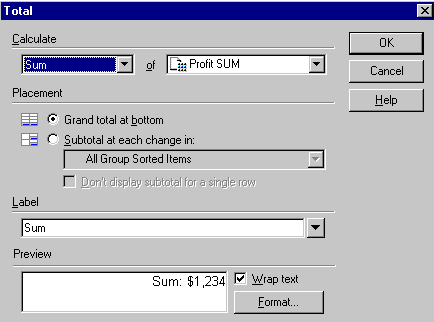
A typical data analysis task is to calculate Item percentages. To calculate percentages in Discoverer, use the Percentages option on the Tools menu.
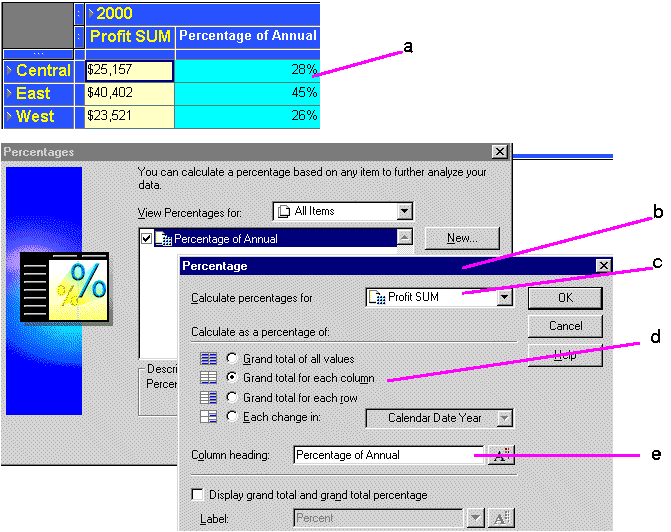
To find a percentage with the Percentages tool on the tool bar:
The percentage column shows the percentage of each row to the total of all the rows displayed on the table or crosstab.
Here are examples of percentages on a Crosstab Worksheet:
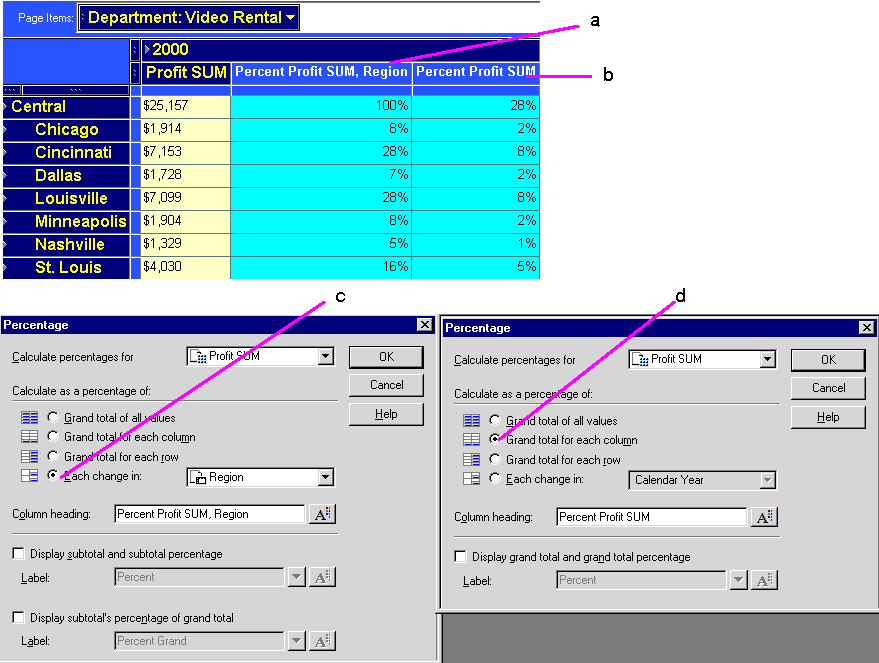
To display percentages on a table or crosstab:
The Percentages dialog box appears. It shows the percentages you've already defined.

Discover now computes the percentages and displays them on the table or crosstab.
To remove the percentages from the data:
The Percentages dialog box appears.
Creating a new percentage definition has four basic steps:
To create a new percentage definition:
The Percentages dialog box appears (Figure 5-28).
The Percentage dialog box for a new definition appears:
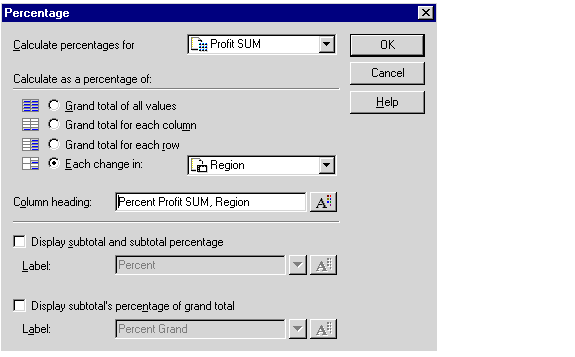
The following table lists your choices:
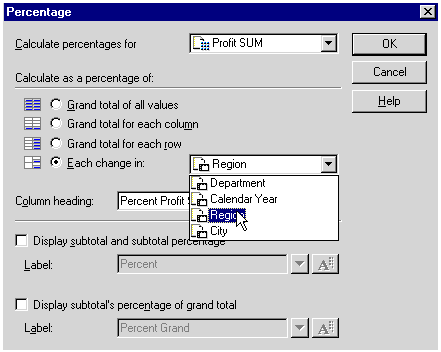
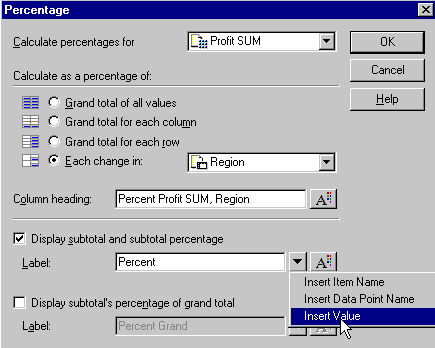
The options from the drop-down menu produce labels that can change as the data changes by adding text codes such as "&Item" and "&Value" where you insert them in the label text. In the actual labels on the table or crosstab, the ampersand (&) will not appear, and appropriate names from the table or crosstab will be inserted in place of the words "Item" or" Value".
The table below shows some examples.
To remove options from the labels, click in the label text on the dialog box and edit it as you would regular text.
To edit a percentage definition:
A typical data analysis task is to filter the data to find only that data that meets certain conditions. For example, you might want to limit the display of data to the last two years of sales. Or, you want to see the data for only two types of sales items. Each of these tasks involves filtering the data to find the specific data that meets the conditions.
Some sample conditions are:
|
Several features for creating conditions involve advanced analysis techniques. For example, instead of creating a condition for a defined data element, you can specify a condition based on a calculated value that computes which data can meet the condition. The advanced features are covered in Chapter 8, "Advanced Discoverer Desktop Features". |
Conditions can be similar to Exceptions. The differences between conditions and Exceptions, however, are significant.
Conditions are essentially powerful data filters that find the specific data you're looking for and displays only that data. You can define numerous conditions and turn them on and off to filter the data in the tables and crosstabs.
Note: Applying a condition to a table or crosstab does not remove the data from the workbook. It merely filters the data to show the precise data you want to see. To return the rest of the data to the table or crosstab, turn off the condition.
To find data that meets certain conditions:
The Conditions dialog box appears.
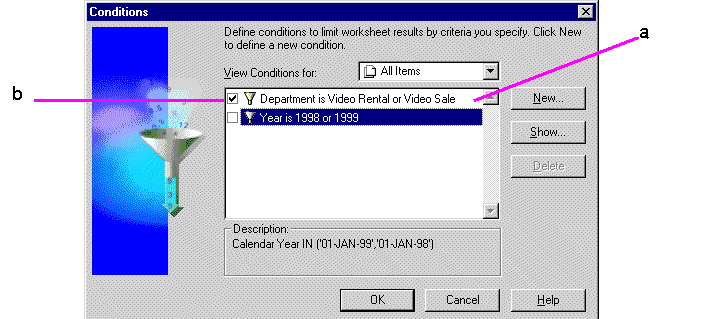
In the example above, the condition "Department is Video Rental or Video Sale" is selected.
To see conditions for specific data items:
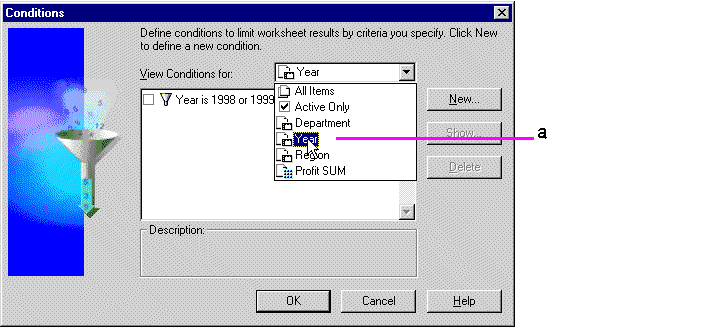
To remove the condition from the data:
The Conditions dialog box appears (Figure 5-32).
Do not click the Delete button. That deletes the condition definition from the list of conditions.
Now, the data is restored to the table or crosstab, because the data is not being filtered. That is, the condition is turned off.
To create a new condition:
The Conditions dialog box appears.
The New Condition dialog box appears:
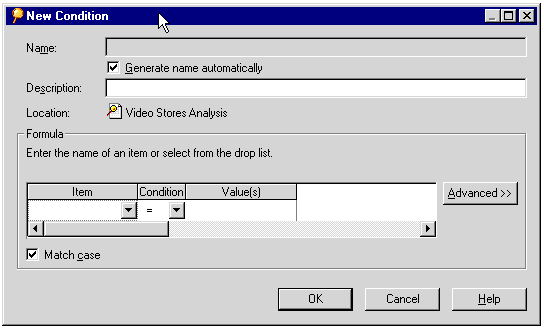
Name--automatically generates a name for the condition based on the item, the condition, and the values that you select for it. To create a different name, clear the check box Generate name automatically. You can then enter a name for the condition in the Name box.
Description--For simple, straightforward conditions, the name and description are usually sufficient to explain how the condition will filter the data, and you don't need to type an extra description. However, advanced conditions may need descriptions for clarity. Enter a description here and it appears on the Conditions dialog box when the condition is selected.
Location--The workbook where the condition will be applied.
The drop-down list shows the data items in the workbook that you can use for the condition. It also lists Create Calculation and Select Condition, which are some other ways to create the first part of the condition.
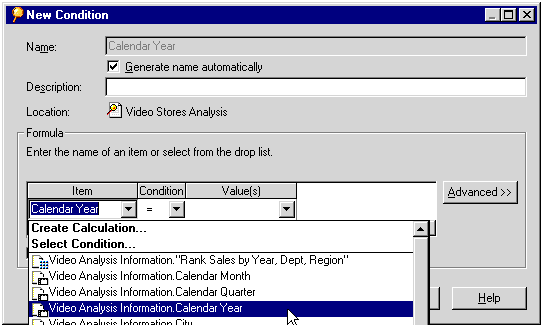
Create Calculation--You can use a calculation to filter the data (see Chapter 8, "Advanced Discoverer Desktop Features").
Select Condition--Creates conditions that use other conditions to filter the data first (see Chapter 8, "Advanced Discoverer Desktop Features").
Notice that the list of items contains all the data items in the workbook, not just those being displayed on the current table or crosstab. You can use any data item to create a condition.

The following table describes the condition expressions:
To create an advanced condition, click the drop-down button to see other options. You can also click the Advanced button for more options. See Chapter 8, "Advanced Discoverer Desktop Features" for a description of the value options and other advanced features.
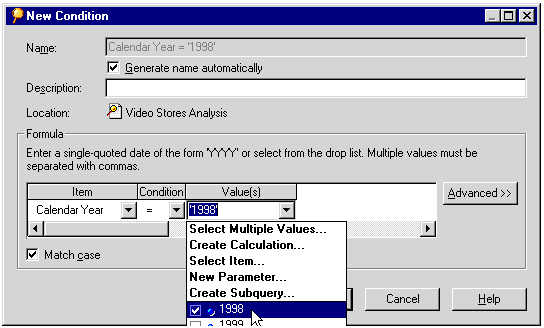
If you select a data item with discrete values, such as Calendar Year, and then select "is equal to" you do not have to type in the value. Click the Value(s) drop-down button to see the list of values for that item, then select the one that you want to use.
For example, in the sample Video Stores workbook, the three values for Calendar Year are 1998, 1999, and 2000.
For example, if you want the condition to filter the data to find all "Widgets" but not "widgets", select the Match Case check box.
To edit an existing condition:
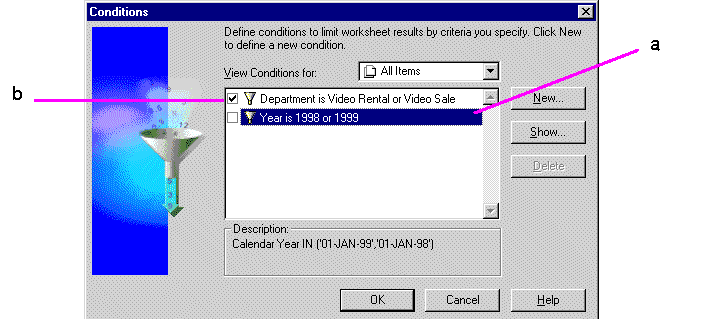
If you now want to apply that condition to the data, make sure it is turned on (the check box in front of the condition is selected) and click OK.
To delete a condition from the list of conditions that you can apply to the data:
The Conditions dialog box appears (Figure 5-38).
|
|
 Copyright © 1996, 2003 Oracle Corporation. All Rights Reserved. |
|